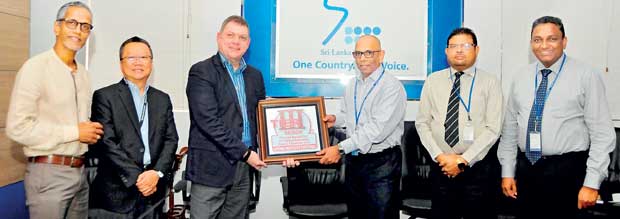22 Feb 2017 - {{hitsCtrl.values.hits}}
 From left: N-able (Private) Limited Managing Director/Chief Executive Peter D’Almeida, Uptime Institute South Asia Senior Director Patrick Chan, Uptime Institute South Asia Managing Director John Duffin, SLT Group Chief Executive Officer Dileepa Wijesundera, SLT Chief Network Officer Priyantha Fernandez and SLT Group Chief Enterprise and Wholesale Officer Kiththi Perera
From left: N-able (Private) Limited Managing Director/Chief Executive Peter D’Almeida, Uptime Institute South Asia Senior Director Patrick Chan, Uptime Institute South Asia Managing Director John Duffin, SLT Group Chief Executive Officer Dileepa Wijesundera, SLT Chief Network Officer Priyantha Fernandez and SLT Group Chief Enterprise and Wholesale Officer Kiththi Perera
As Sri Lanka Telecom (SLT) was aiming towards instigating the construction of a new state-of-the-art Internet data centre (iDC) that would enhance the provision of a secure and reliable data hosting facility to Sri Lanka, the Uptime Institute had recently awarded SLT with the design certification required to carry through
the initiative.
Having received the go-ahead from the global data centre regulating body, SLT is set to construct a large-scale state-of-the-art and energy-efficient data centre with world-renowned Uptime Tier
III Certification.
SLT will also strategize the inclusion of a Gold Rated green building certification (Gold Rating), which has been planned to be obtained from the Green Building Council of Sri Lanka. The world recognized Tier III and green building certifications stand towards the regulation of contributing to reduce the carbon footprint alongside the role of providing the best services to
all customers.
SLT hopes to inculcate tactical development to the location of Pitipana, Homagama and the surrounding areas in terms of attracting new business opportunities in business continuity and recovery areas. The new iDC in Pitipana will be constructed as a three-storied building spanning an area of 5800 sqm and will be located 24 kilometres away from the SLT HQ data centre. The iDC can also be reached in 8.4 kilometres once leaving the nearest expressway exit.
Business establishments will therefore benefit from cost- effective measures that would also enable them to outsource ICT functions with SLT’s iDC and stray past in-house data management. The iDC will also provide competent grounds for the requirements of enterprise customers’ disaster recovery (DR).
A good expanse of the service facility will allocate 500 racks with a power density of 5 kW per rack. Companies can now gradually embrace the opportunity of outsourcing to the cloud and become part of the blueprint of the new iDC.
The iDC will therefore assist in drawing down global business opportunity to the country at the same time as providing a secure and consistent data hosting facilities in alliance with the Government Cloud. Anyone who reside or operate from the city limits of Colombo can easily access the new iDC, which will be about 32 kilometres away. Arriving directly from Bandaranaike International Airport, tourists or business travellers can reach the iDC via the expressway in as little as 45 minutes.
With Sri Lanka on the pathway of achieving a status as a global information hub, SLT plays a major role in stepping up the objective of developing digital infrastructure facilities in Sri Lanka. SLT has also recognized the significance of increasing the capacity of data centres in Sri Lanka in the near future if the country is to service a diversified level of demand in the market. This specific entity is being deemed as a vital milestone that has to be achieved within this
influential project.
Commenting on the upcoming iDC development, Sri Lanka Telecom Group CEO Dileepa Wijesundera said, “This will spell a revolutionized approach in Sri Lanka’s next step into digitalization and e-transformational progression. It is vital to note that Sri Lanka is one of the main countries in the region to have embraced this swift approach into the Internet-of-things.
The government has recognized the need and significance of progressing further and placing the country high up in the region as a major digital hub. At SLT, this establishment drives towards the cloud strategic vision of evolving from the basis of connectivity to the phase of service orientation.”
Wijesundera also emphasized on Sri Lanka’s stance in upgrading its digital landscape through the concept of e-transformation, which would not only support large businesses to progress but small and medium sectors (SMEs) as well. This revolution in the provision of services would also pose as an advantage for BPOs and KPOs that specialize in the communications and services sector in both, the private and public sectors alike.
07 Jan 2025 4 hours ago
07 Jan 2025 4 hours ago
07 Jan 2025 5 hours ago
07 Jan 2025 7 hours ago
07 Jan 2025 7 hours ago